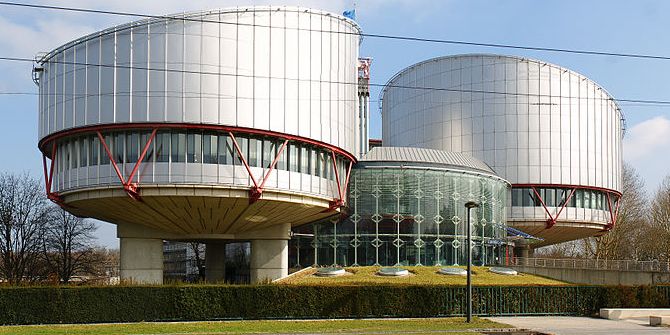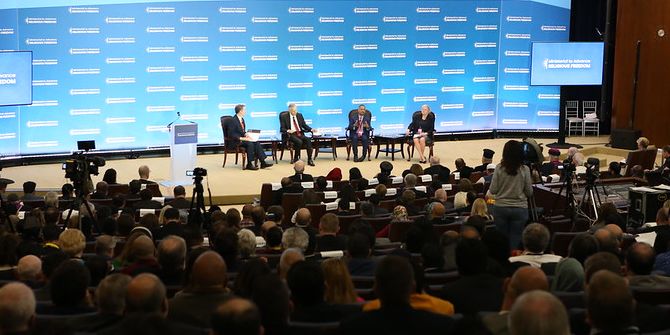Despite the ‘rapid judicialization’ of religion at the European Court of Human Rights, the Court and its rulings remain unknown to many grassroots actors. Through the Grassrootsmobilise Research Programme, Effie Fokas has led a comparative study of how national conditions in Greece, Italy, Romania and Turkey continue to influence levels of civil society engagement with the Court.

In May 1993 the European Court of Human Rights (ECtHR, or the Court) gave just satisfaction to Minos Kokkinakis, a Greek Jehovah’s Witness who had been arrested more than 60 times for the crime of proselytism. It was the first case, after its then 33 years of operation, that the Court had issued a judgement finding a state in violation of the freedom of religion or belief (FoRB). Since that 1993 judgement the Court has issued over 80 more, calling states out for FoRB infringements. Against the backdrop of this rapid judicialization of religion at the ECtHR it is worth considering, as one measure of successes and failures of FoRB on the ground, the extent to which the ECtHR’s FoRB-related decisions are known at the grassroots level and used by social actors on the ground to win their own ECtHR-established rights.
The ECtHR has addressed some of the most contentious issues around religious or belief rights – from whether religious symbols may be displayed, or worn, in public spaces or in the workplace to whether conscientious objection to counselling of same-sex couples, or to baking their wedding cakes, can be defended. In some such cases, the Court calls for radical legal change, and in others it is seemingly radical in not calling for legal change, but in all cases it takes decisions with potential relevance for over 800 million people living across 47 countries in Europe and beyond.
Its importance is widely recognised on a global scale: ECtHR decisions are international standard setters in human rights law, cited by national and international courts globally, and NGOs and member states have mobilised powerfully prior to and in the aftermath of some of its decisions. Yet, as has been ascertained through relevant European Research Council-funded research, the ECtHR remains rather unknown to most grassroots social actors with a vested interest in FoRB, and its specific decisions even more so. The latter suggests a tremendous gap between the Court’s potential and real impact at the grassroots level.
Specifically, the Grassrootsmobilise Research Programme (2014-2019) examined the extent to which the Court’s rich case law in the field of religion helps to shape grassroots level actors’ awareness of and pursuit of their relevant rights, whether through legal or political means. In so doing it found that the ECtHR has vastly unfulfilled potential to influence religion-related rights on the ground. The scope of ‘religion-related’ in the said research is broad; it includes issues likely to mobilise religious or secularist, atheist or humanist social actors and thus extends to such issues as social ethical concerns regarding same-sex rights and bio-ethical questions regarding assisted reproductive technology or euthanasia. Thus the Court is an underused resource for a rather broad range of social actors (i.e., those with a vested interest in religious minority rights, religious majority concerns, religion-state relations, the public presence of religion, non-discrimination for LGBTI individuals, bodily autonomy for women, etc.)
Of course, there are variations in the levels of engagement with the Court and its religion-related case law from one country to the next, and within each country. This much is clear through the comparative study of four country contexts – Greece, Italy, Romania and Turkey – all countries in which strong relationships between religion and national identity, and between church and state, render highly salient, in theory at least, the Court’s pronouncements that bear the potential to influence the public place of religion. Comparisons between these cases show the significance of such factors as national political and legal opportunity structures (to what extent is political lobbying likely to be more effective in a given country context on a given issue?); where the ECtHR stands within the national legal order (de jure and de facto); where the majority faith stands within the ‘national religious order’ (given the fact that in all cases there exists some hierarchy between religious groups); and the national track record in relation to the ECtHR (in terms of the extent to which states tend to implement its decisions).
There are also significant variations from one conscience-based group to the other. For example, groups more likely to litigate such as the Jehovah’s Witnesses and the Church of Scientology, often employ in-house lawyers, and these groups in particular have extensive experience litigating before the ECtHR; both factors tend to underpin higher levels of awareness of the Court and its case law amongst members of these groups. At the opposite end of the spectrum, members of migrant Muslim communities tend to exhibit lower levels of awareness of and interest in ECtHR religion-related case law, both because FoRB is more of a ‘luxury’ in comparison with more immediate concerns such as the right to residence, but also in part because of a sense in which going to the ECtHR is a fundamentally anti-national act. As one Italian Muslim group representative put it, ‘You can file a case to the court, of course but [that] is already the “hard way”, it’s confrontational, whilst we want to be moderate and responsible citizens’. Here a Muslim respondent emphasizes the importance of the public image of Islam especially in the context of the high politicization of Islam and the political polarization around Islam-related issues.
However by far the most prevalent reason, amongst non-legal social actors at least, for low levels of awareness of and engagement with decisions of the ECtHR in the realm of religion is perceptions of case law, in general, as of relevance to and penetrable only by lawyers. This factor is especially pertinent, of course, to ECtHR case law given that the Court is, like other European institutions, broadly perceived as non-transparent and distant from the individual European citizen. That said, grassroots social actors exhibit a strong interest in learning about the Court and its case law relevant to their interests, especially in learning through ‘unintimidating’ means which vernacularize the Court’s decisions for non-legal audiences. The latter point suggests that novel approaches to disseminating information about the Court and its case law could go a long way both towards enhancing FoRB on the ground in Europe and towards bridging a gap between citizens and this European institution.
Note: This article is part of our ‘Real-World Approaches: Freedom of Religion or Belief‘ series
Note: This piece gives the views of the author(s), and not the position of the LSE Religion and Global Society blog, nor of the London School of Economics.





